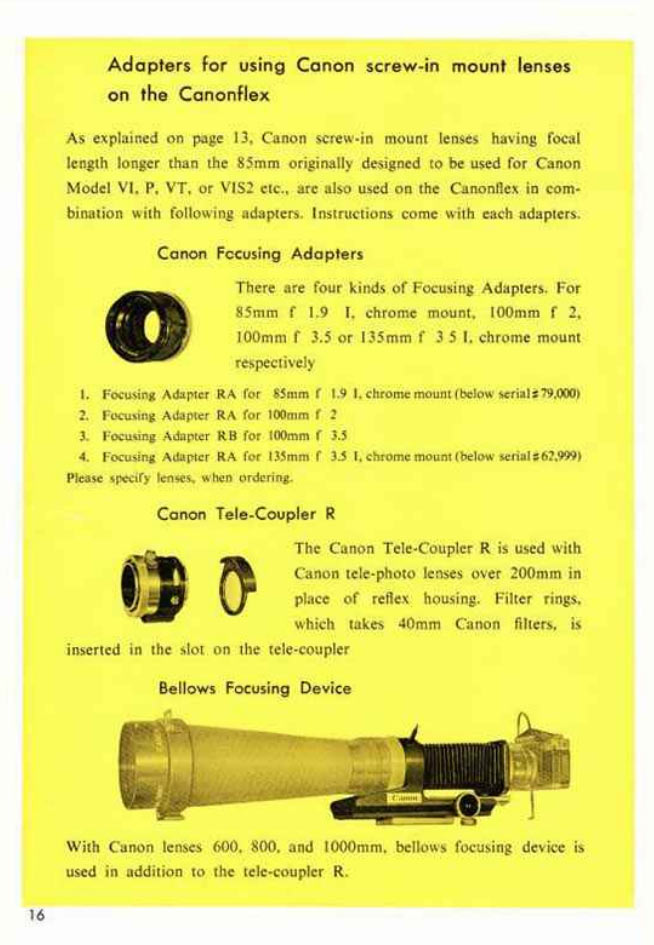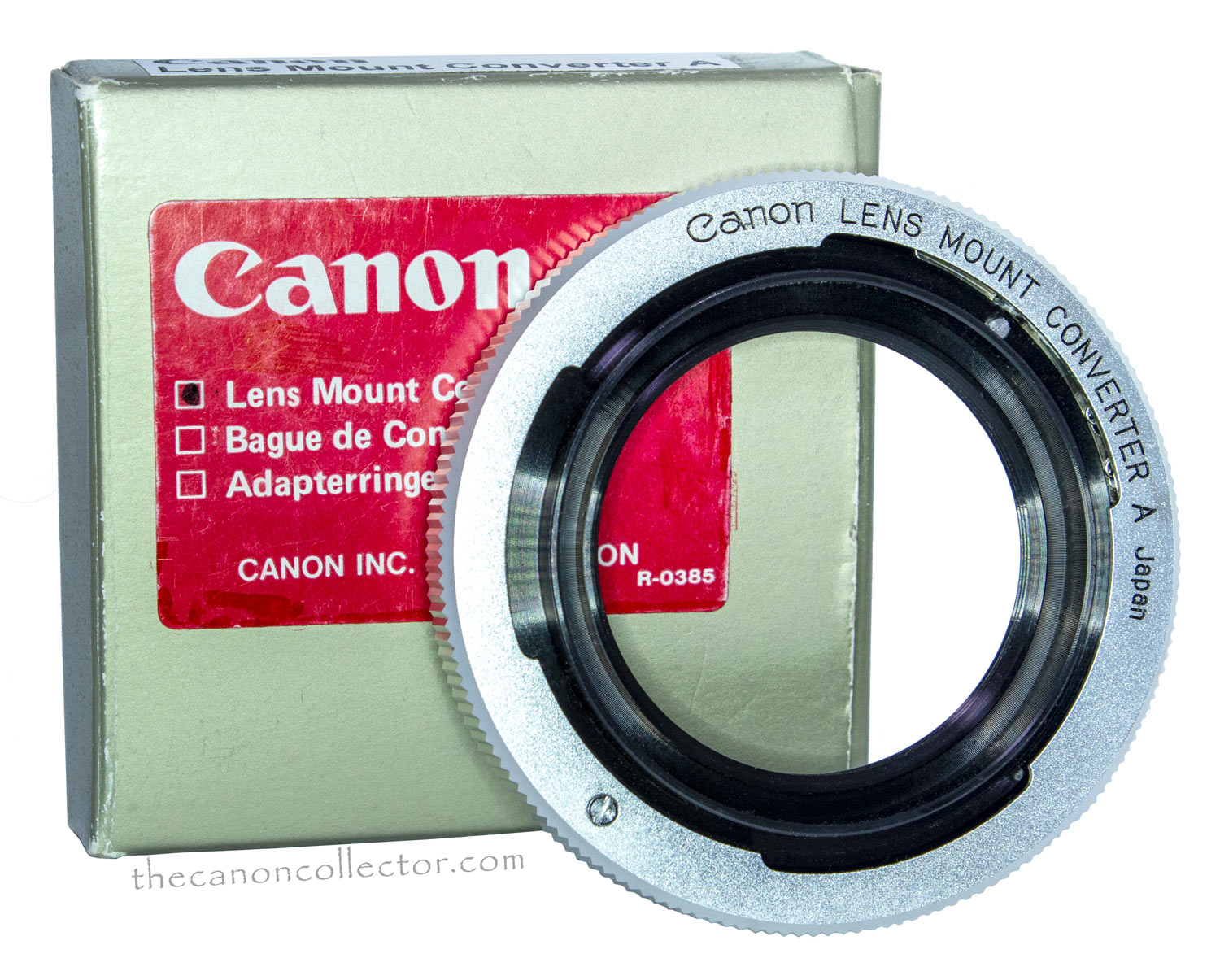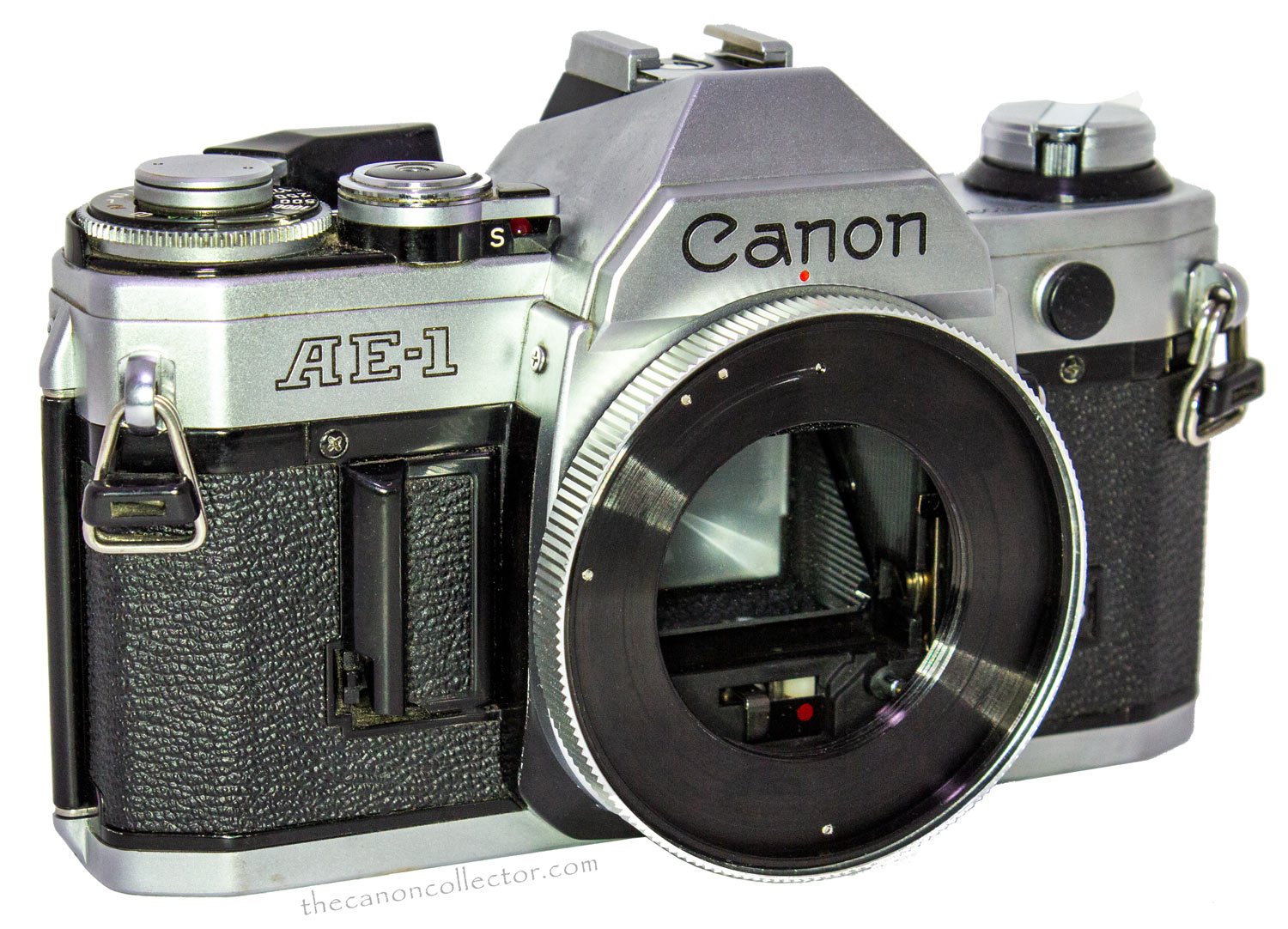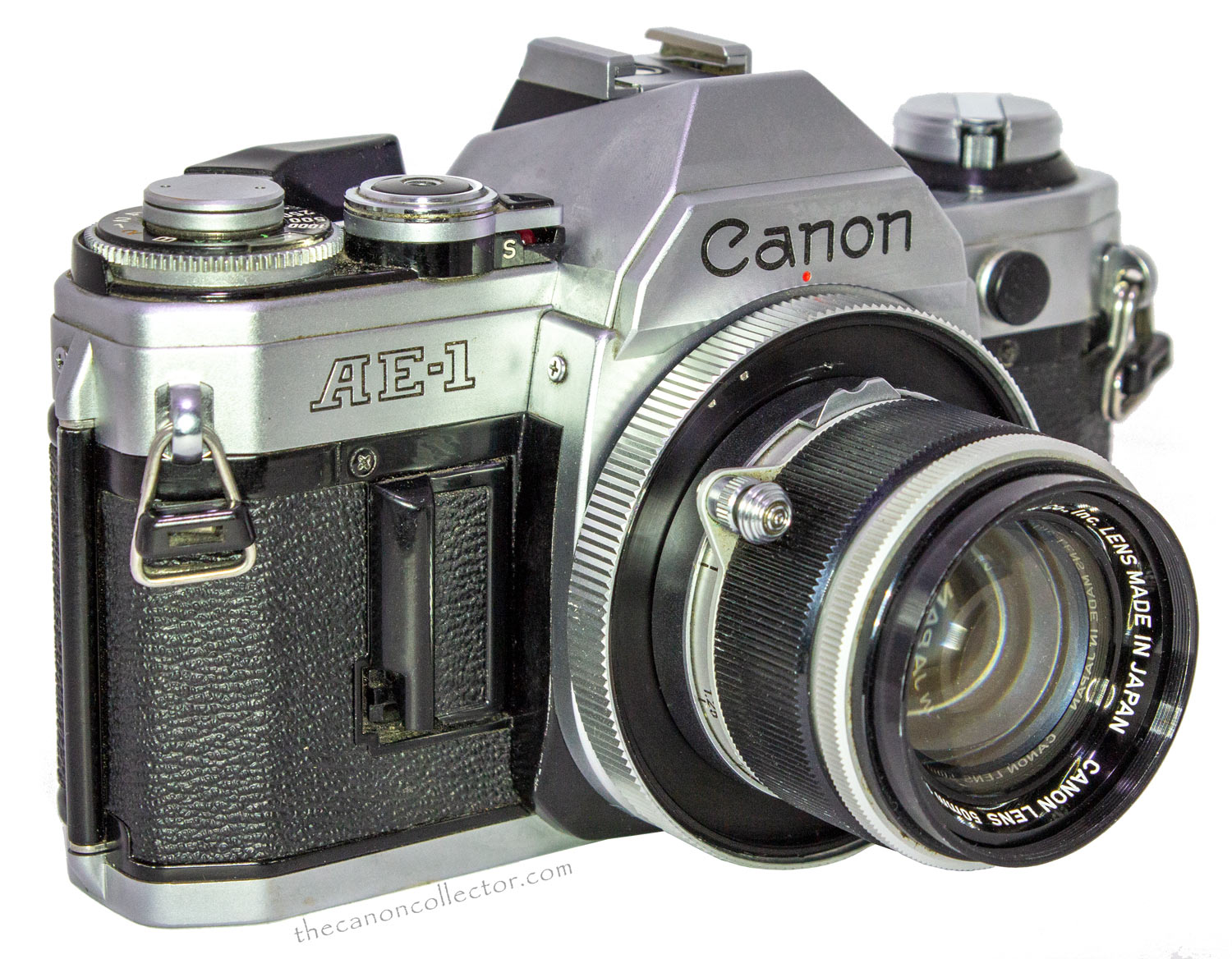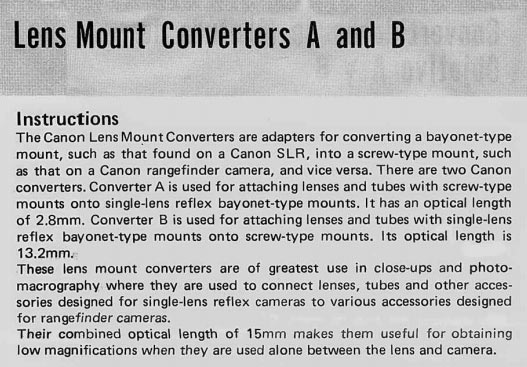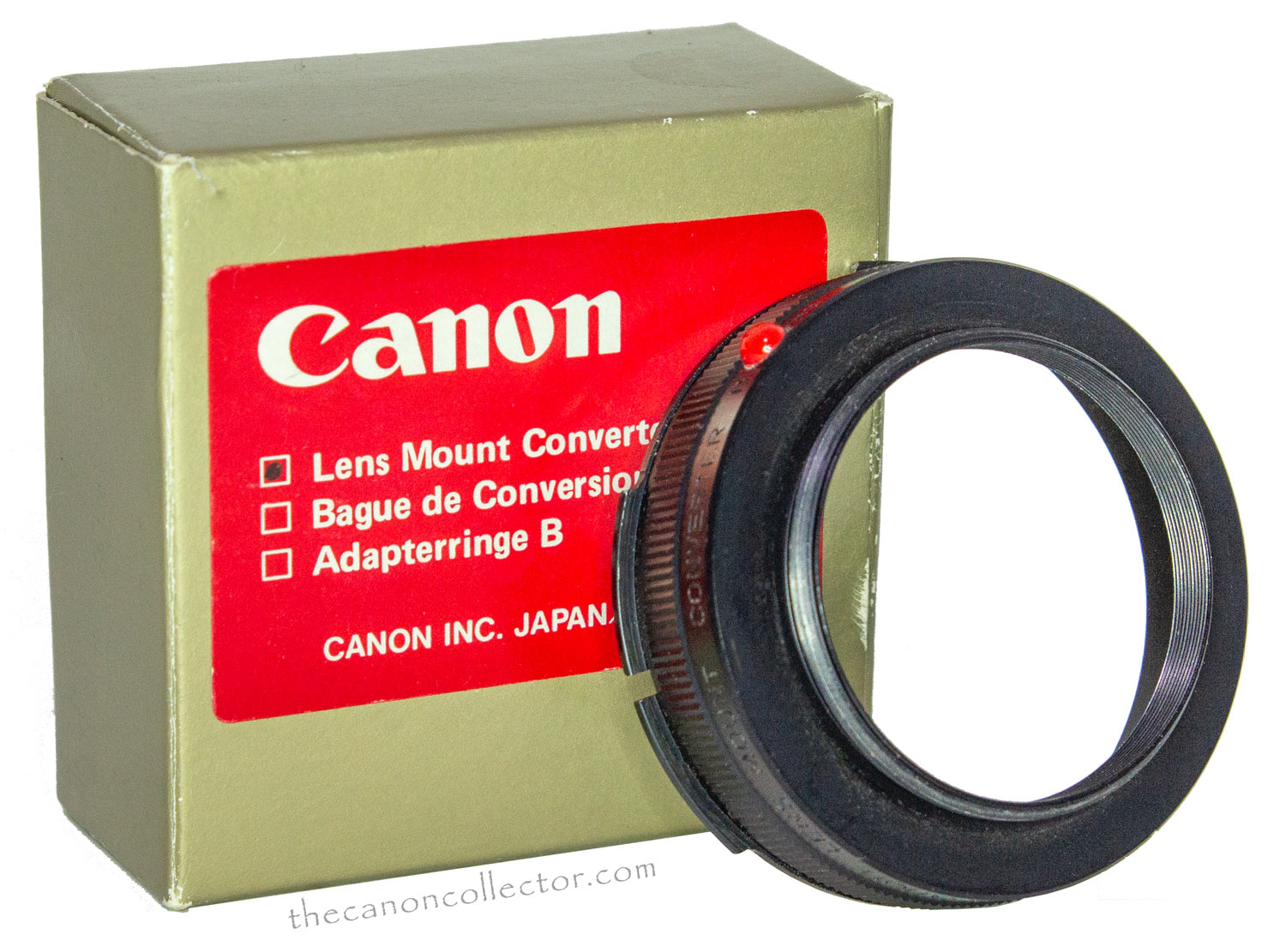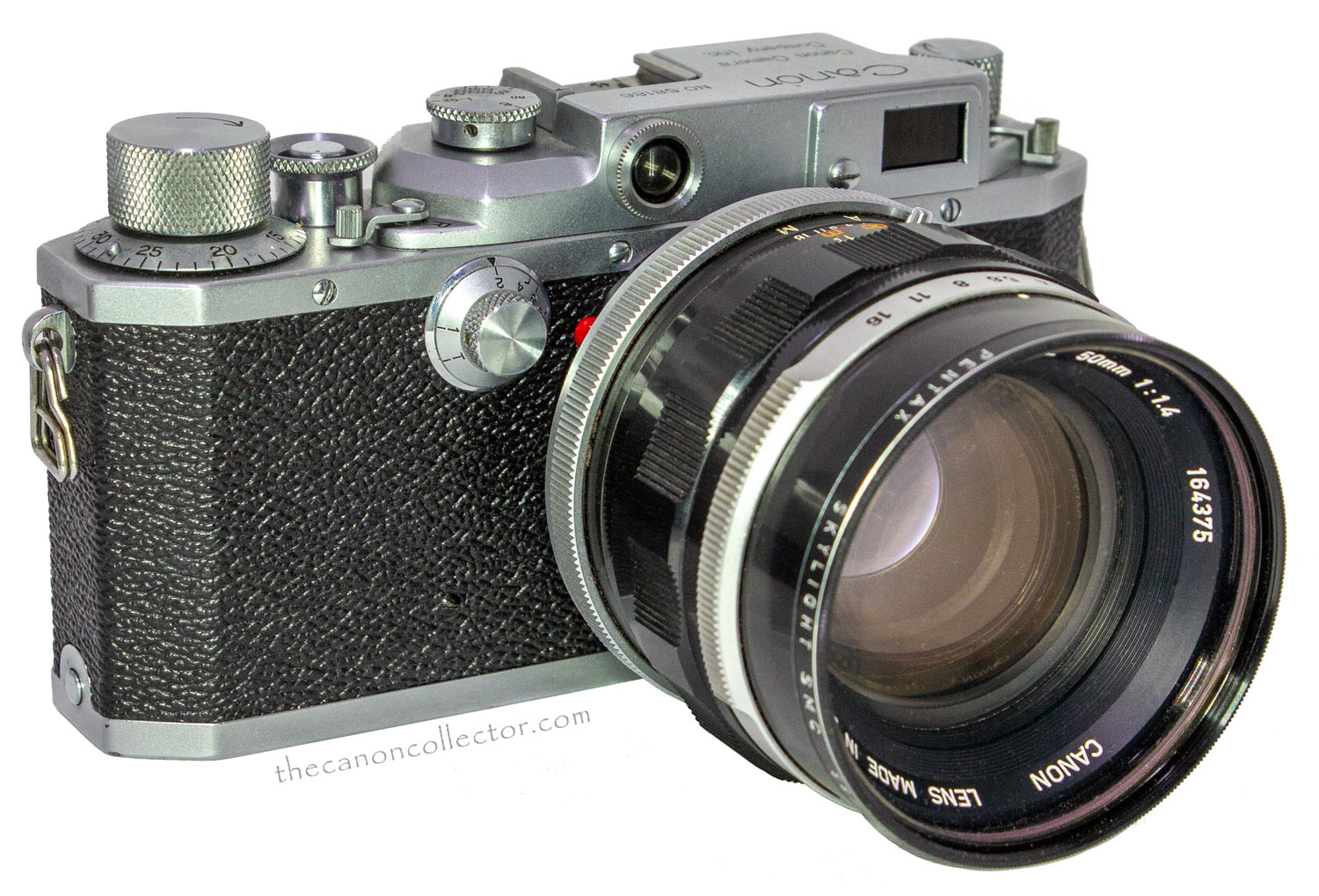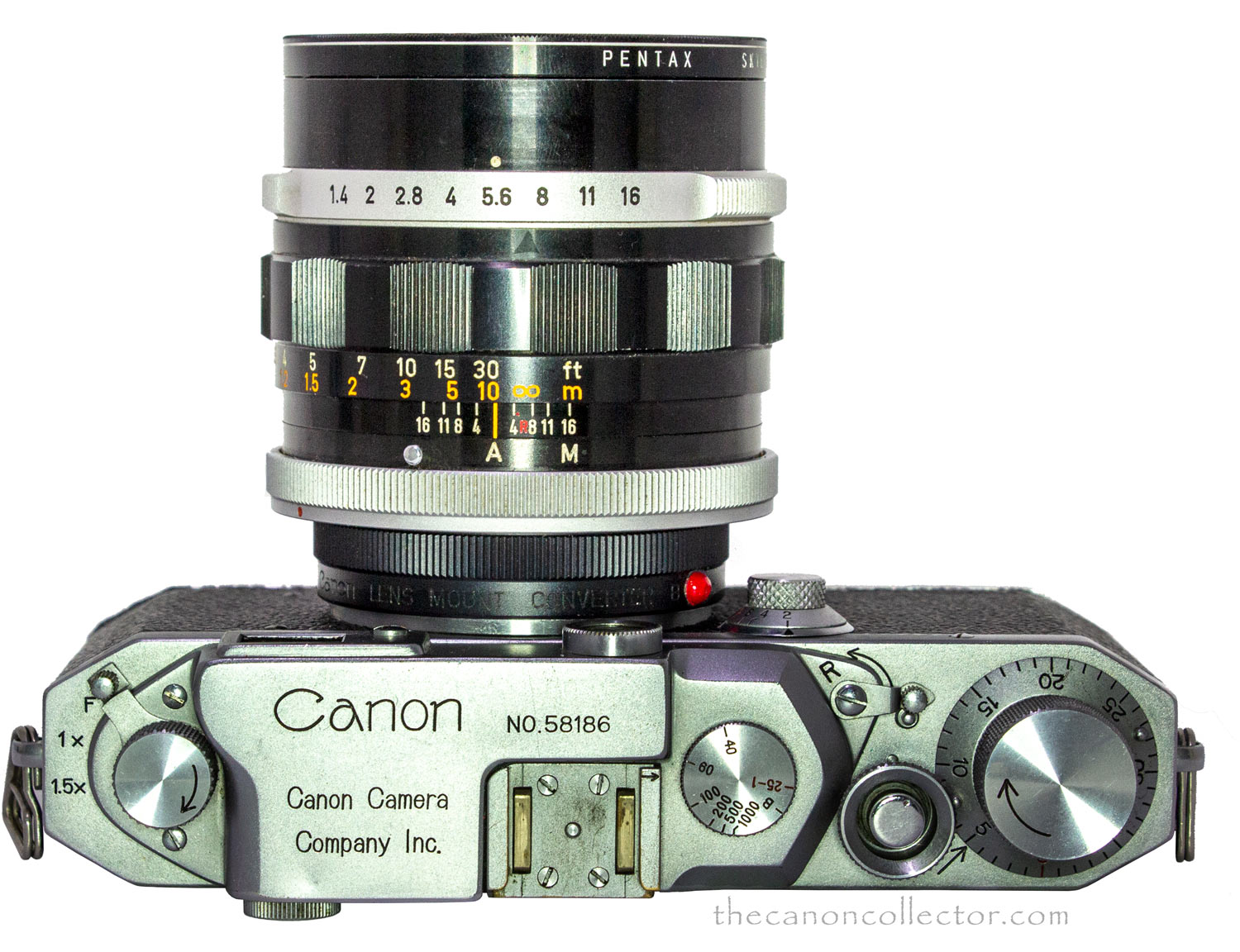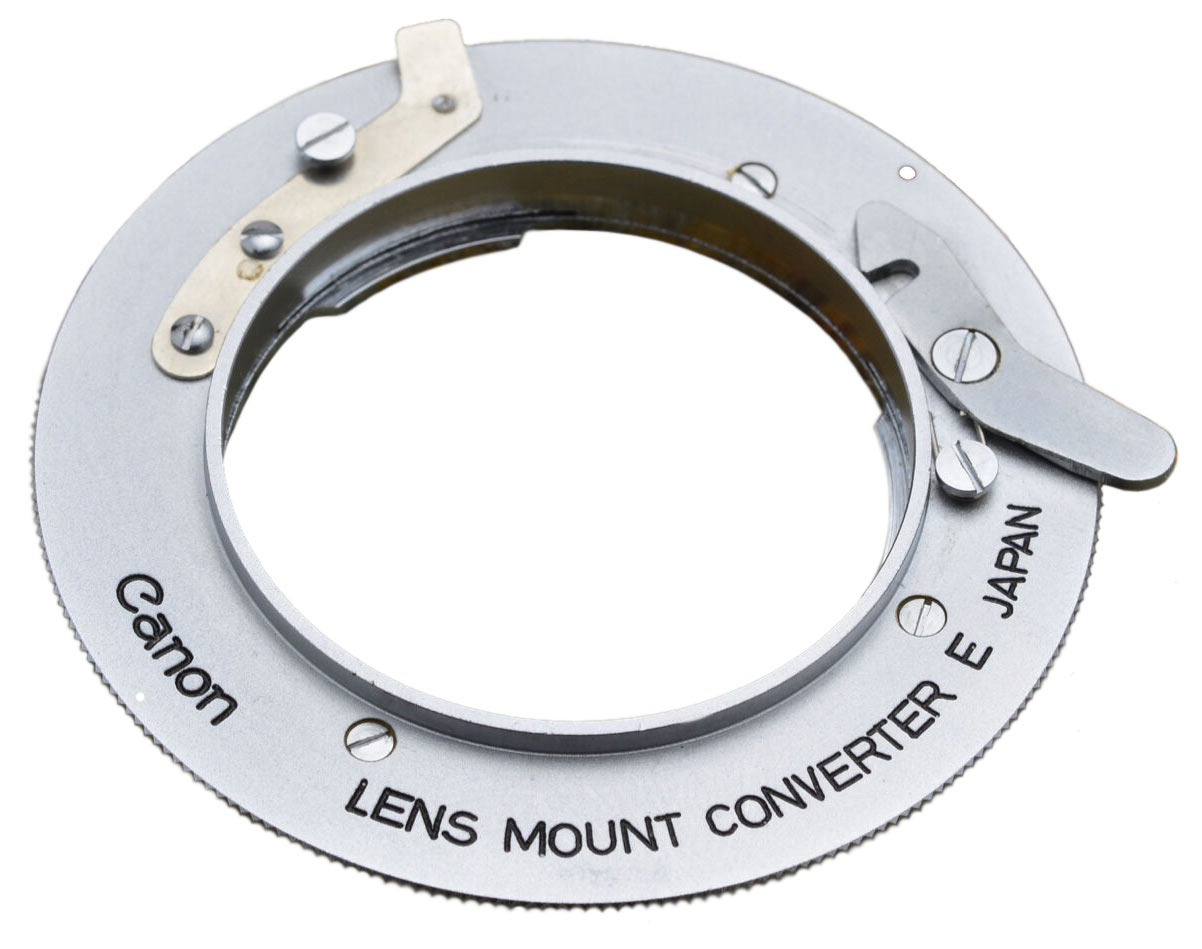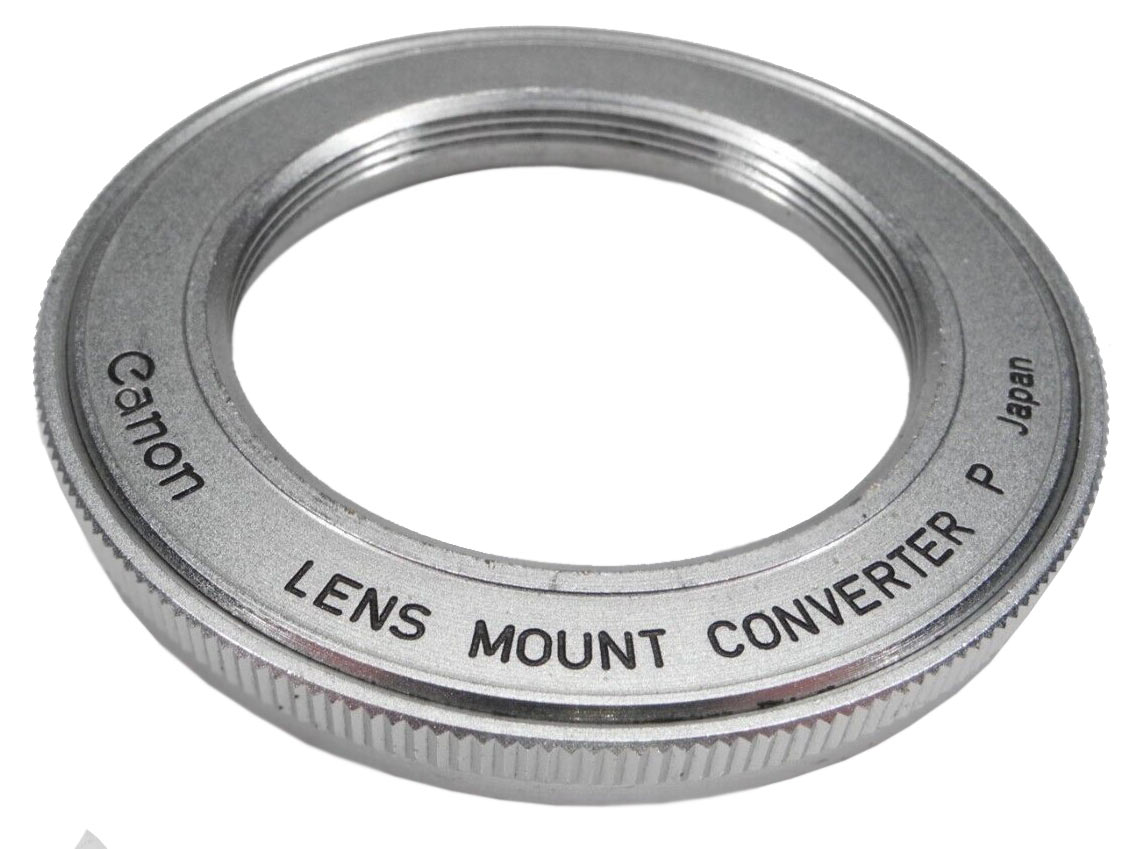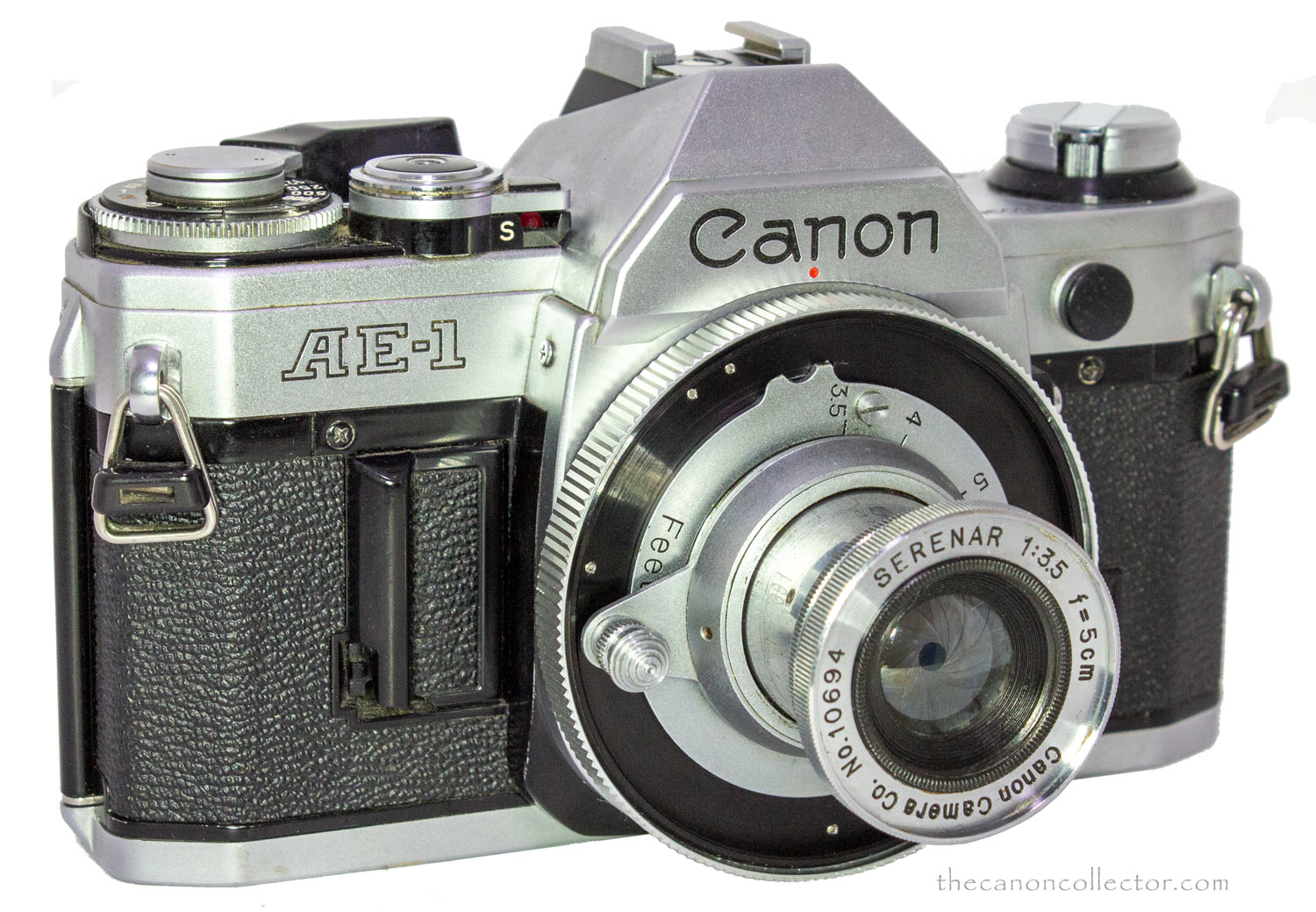
This is one of my SLR AE-1’s with a Serenar 50mm f/3.5 rangefinder lens mounted on it. This has been done with the Canon Lens Mount Converter A.
Lens Mount
Converters
I was at a Camera Show here in Vancouver about two months ago and I saw a man with a Canon Model III rangefinder camera and he had an FD lens mounted on it. We got to talking and I found he was using a Canon Lens Mount Converter. This was new to me so I looked into it a bit and it is really interesting. It may not be something we will use in the future but that never stopped a true collector!
There is not much written about these Converters, as seems to be the norm for all Accessories. I only have two of these devices so far so what I write about the rest is what I can glean from my small library and the internet. It is not the whole story. I will have to get examples of the other Converters before I can finish this report. So, this page is not complete but is an ongoing research report.
What are Lens Mount Converters?
Simply put, a lens mount converter allows a lens mount to accept a lens from a different type of mount, sometimes even a lens from another company. For Instance, Canon made a Converter to allow an M-39 mount lens to mount on a Canon R, FD or FDn mount. In the photo above you see a Serenar M-39 mount lens on an AE-1 SLR. Looks weird but it does work, sort of.
The problem with the above arrangement is that the lens will not focus to infinity. The Flange Distance is wrong. A lens cannot focus to infinity if it is on a mount that has a greater Flange Distance than the lens. In this case, the FD mount Flange Distance is 42.0mm but the M-39 lens Flange Distance is 28.8mm. This combination cannot focus to infinity without the addition of correcting lenses which is another whole problem.
Another point to note is that unless I say otherwise, these Lens Mount Converters all require the lens aperture to be set by hand. But I will talk about that as we discuss individual Converters.
As long as Canon was making rangefinder cameras there was no need for Lens Mount Adapters. Prior to the introduction of the Canonflex and the R mount I can find no reference to such a device. However, on Page 16 of a Canonflex Brochure from 1959 I find reference to something called a Focusing Adapter.
Page 16 from the 1959 Canonflex Brochure
The information on this page is not much to go on. I see comments online that the specific lenses referenced allowed the lens section of the barrel to be separated from the focusing helicoid section and mounted on the Focusing Adapter designated for it. Apparently this allowed for infinity focus. However, only the specific lenses mentioned could be so used. And , of course, the aperture had to be set manually.
When the Canonflex was introduced the lenses available were limited. Canon ported several M-39 lenses from their rangefinder lineup to the new R mount by changing the mount on the lens. This was done with the S 135mm f/3.5 II which I have written about in these pages.
I think the Focusing Adapters were motivated by the same desire to swell the lens lineup for the Canonflex without the necessary time and development costs involved in new lenses.
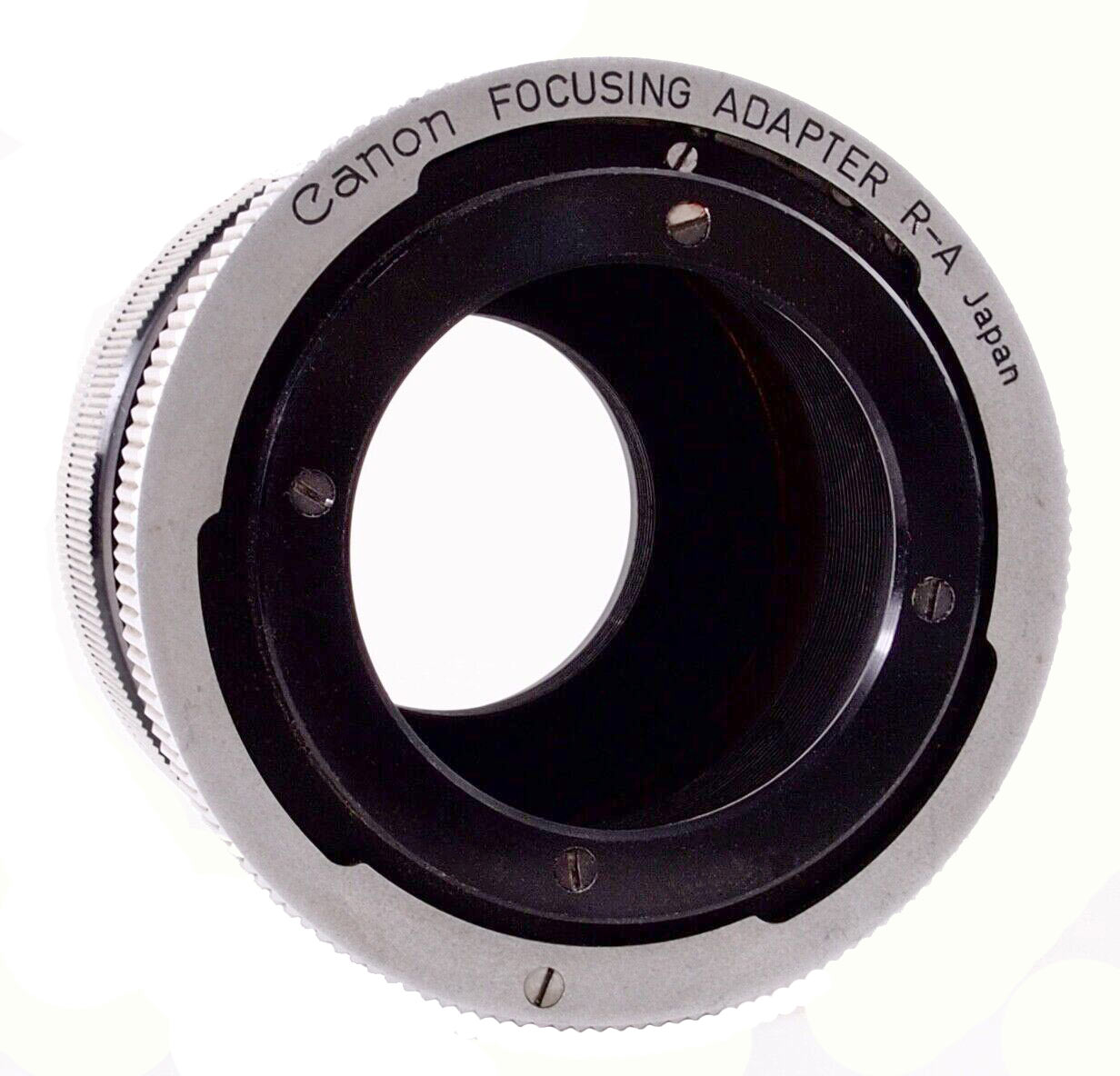
This image taken from E-bay shows a Canon Focusing Adapter R-A. It appears to have no correcting optics so I am not sure exactly how it works. In the image below of the other end you can see that this is the Adapter for the 135mm lens.
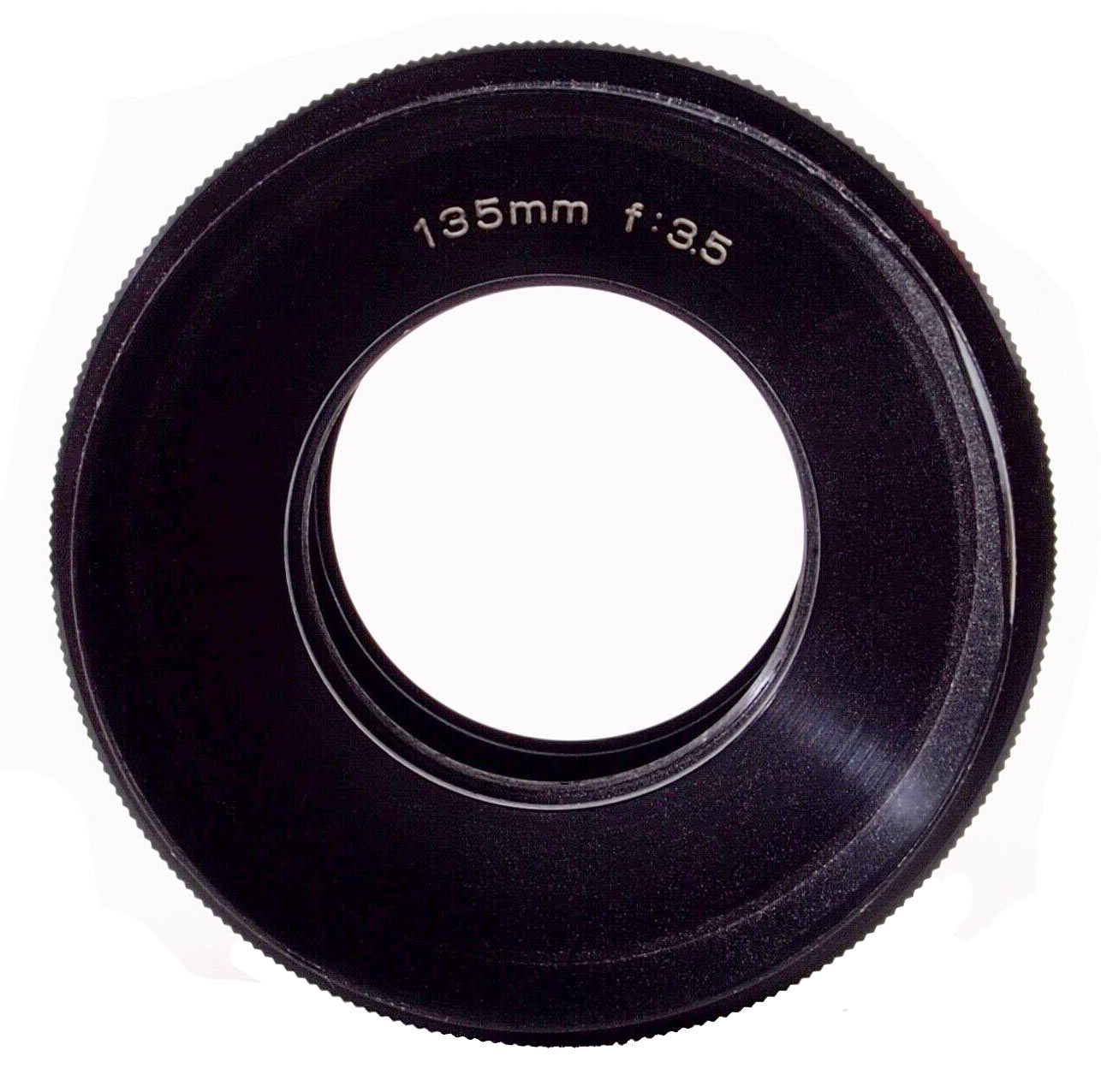
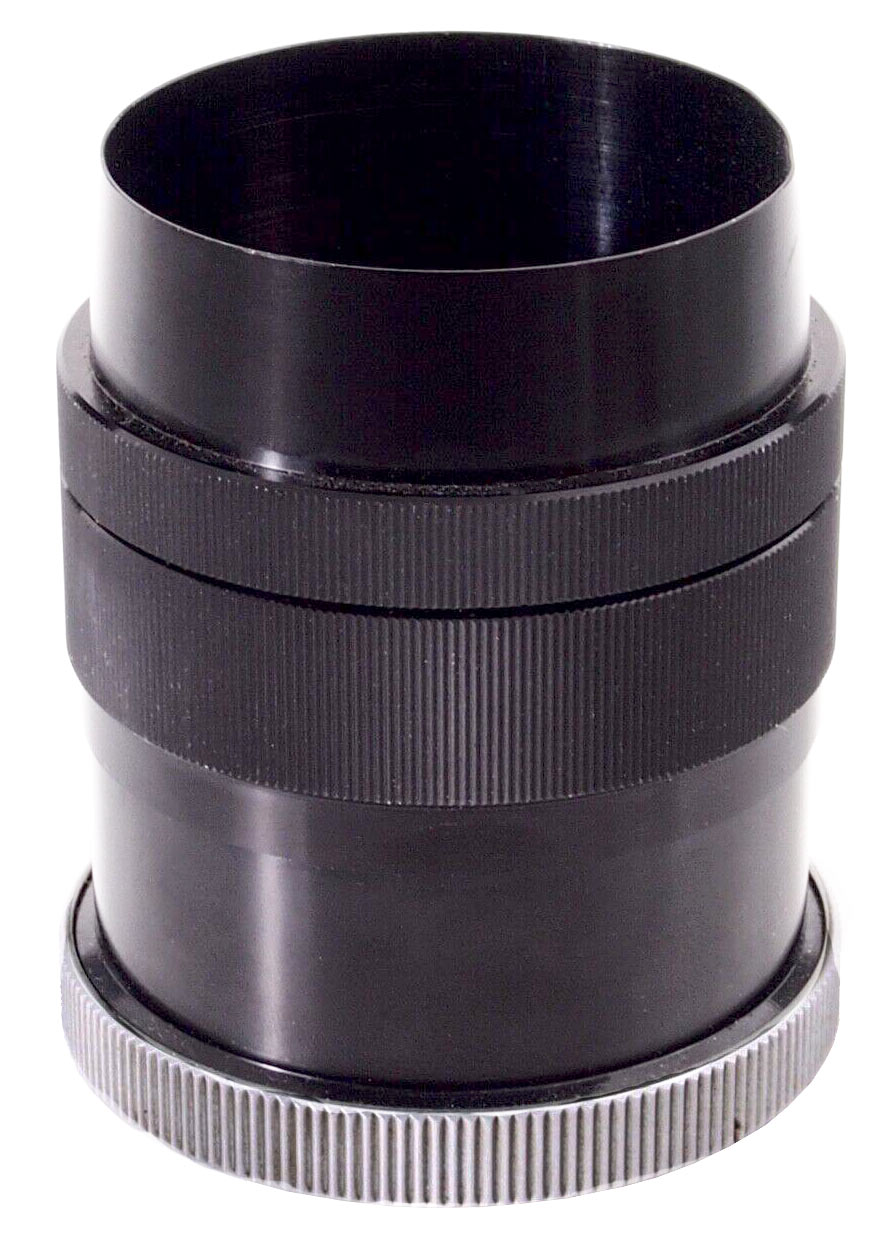
The same Adapter from the side. The R mount silver locking ring is at the bottom. There appears to be no thread in the top for an M-39 lens. So I am perplexed. I need to acquire one of these to figure it out. Or find a manual for it.
These adapters were short lived. In the March 1962 Bell & Howell Catalogue there is no mention of them although extensive accessories are mentioned for the Canonflex. But, of course, the whole Canonflex system was short lived.
Because they were not offered for very long they have become rare in the collector market and hard to find. The images here are from the only listing on E-bay currently.
This is the Canon Lens Mount Converter A. The camera mounting silver collar is on the outside and the inside of the hole in the center has the Leica M-39 threads.
The Canon Lens Mount Converter A mounted on one of my AE-1’s without a lens mounted in it. Notice how thin the adapter is and the threads inside the opening in the Converter.
This is the same AE-1 with a Canon Lens 50mm f/1.8 II lens mounted on it. The infinity focus lock is moved away from the back of the lens and is not obstructed by the Converter.
Lens Mount Converters, introduced in the very early 1960’s and sold into the 1970’s were a more sophisticated follow on to the earlier Focusing Adapters. The first evidence I see for them in in Bell & Howell Catalogue of March 1962. Listed on Page 12 are Lens Mount Converters A, B, and E.
Lens Mount Converter A allows any M-39 lens, not only Canon’s but any Leica Screw Mount lens, to be mounted on any R or FD camera. But, and it is a big but, the lenses will not focus to infinity. The flange distance of the SLR camera bodies is much greater than the flange distance on the Canon M-39 rangefinder camera. So, no infinity focus. The lenses can only be used for macro photography.
The picture at the top of this page shows the Serenar 50mm f/3.5 collapsible lens on the AE-1. Another problem with the Lens Mount Converter A is that the infinity lock button on the lens, and maybe others, will not depress to disengage from the infinity setting. To seat the lens so that the focus helicoid will work the lens must be off the infinity setting.
The only way to solve the infinity focus problem is to add a correcting lens integral to the Converter. Canon did not make such a device.
To be honest, I have trouble seeing what use this device would be. Macro photography obviously but nothing else. I guess that might have been useful on the Canonflex but when you get to the “F” series there are so many other options. I assume it was an easy device to make and Canon could say how versatile their photography system was.
The same Instruction Sheet came in the box with both Converter A and Converter B. It really does not tell you much you can’t figure out just looking at the devices.
This is the Canon Lens Mount Converter B. The Converter screws into the M-39 rangefinder mount and then any R, FD or FDn lens will attach to it.
The Lens Mount Converter B is a little more useful in that it allows R, FL, FD or FDn lenses to attach to an M-39 lens mount. This means almost any Canon rangefinder, but also any Leica or other camera with an M-39 threaded mount. This Converter is also listed in the Bell & Howell Catalogue of March 1962. Listed on Page 12 are Lens Mount Converters A, B, and E.
This works because the flange distance of the M-39 mount is less than the flange distance for R, FL, FD or FDn lenses. The lenses will focus to infinity. So the device is much more useful than the Converter A.
This Converter comes in black or silver. Mine is black but the one I saw at the camera show that got me going on this topic was silver. They function identically.
The lenses must be “zone” focused as there is no coupling to the rangefinder. And light level must be measured by a hand held meter. But otherwise all of the SLR R, FL, FD and FDn lenses can be used.
This combination confused me when I first saw it until I realized what it was. My first thought was that there was a whole class of lenses I knew nothing about. There is no question that this arrangement is a real “head turner”.
This is a Canon rangefinder camera with an FL 50mm f/1.4 lens mounted on it. This is a combination the will confuse other photographers on seeing it.
I do not have this Converter and so this image is from E-bay which is a wonderful research resource. I think lenses will focus to infinity using this Converter because flange distance for an Exacta lens is 44.7mm but that for a Canon R, FL or FD lens is less at 42mm.
The Lens Mount Converter is listed in the Bell & Howell Catalogue of March 1962 along with the Converters A and B.
When these Converters were first introduced in the early 1960’s Japan had not yet come to dominate the camera market and flood it with very excellent Japanese optics. There were far more high quality German lenses available and the Exacta lens mount was very popular. It made sense to provide for the mounting of these lenses.
The Exacta mount was a bayonet mount with a latch on the side that secured the lens in place. The mount was introduced in 1936 on the Kine-Exakta camera by Ihagee and was in use until 1977. Many other manufacturers made lenses and cameras with this mounting.
I don’t have one of these to test but flange distance for Exacta lenses is 44.7 mm while that for the R, FL and FD lens mounts is 42mm so infinity focus is likely with this mount. Of course, the lens operation is totally manual with this Converter.
The Lens Mount Converter P is anothe Converter I do not have. But then I have no M42 lenses either. So much to collect and so little money! This is another E-bay picture.
The Lens Mount Converter P allows the use of M42, also known as the Praktica Mount or the Pentax Mount, lenses on Canon R, FL or FD bodies.
The M42 lens mount was developed by Carl Zeiss at their Jena factory in 1938 for use on Praktica cameras. It is a thread mount like the leica but it is a 42mm diameter thread with a 1mm thread pitch. Flange distance is 45.46mm which means that this mounting can be used on Canon cameras and still maintain infinity focus. Again, the lens used like this is totally manual.
Early Pentax SLR’s adopted this thread mount which made it a very common lens mount. There are many excellent lenses available that can be used with this converter.
In 1959 Nikon intoduced the Nikon F Lens Mount. This was a three lug bayonet mounting with a 44mm throat. The flange distance was 46.5mm which meant that infinity focus could be obtained on an adapter for mounting such a lens on a Canon R, FL, or FD SLR. This mount was very popular and remained in continuous production for over 50 years.
Not only Nikkor lens were made for the F Mount but Zeiss, Voigtlander, Schneider and a host of others made lenses for this mount. There was a strong demand for a Lens Mount Converter for the F Mount.
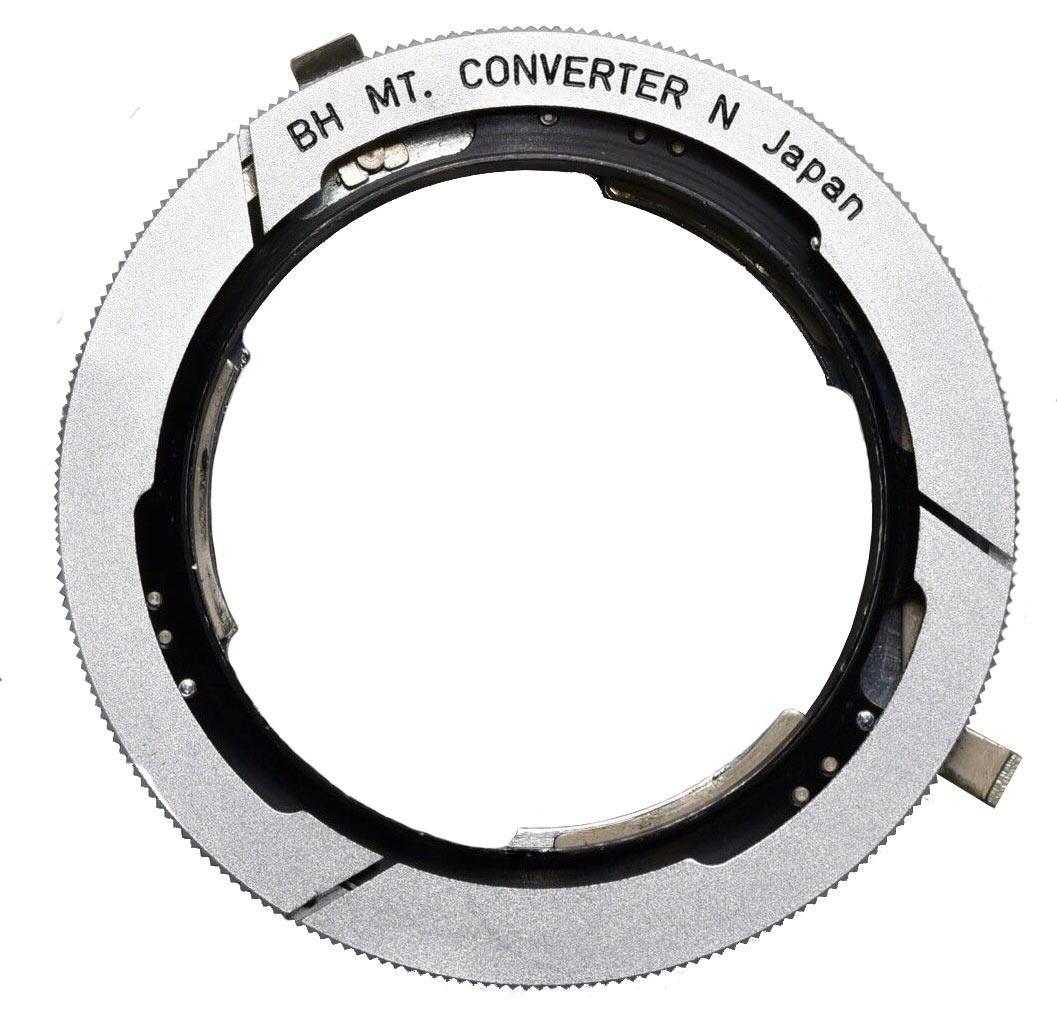
The Lens Converter N came in two versions. This is the first one from the early 1960’s when Bell and Howell represented Canon in North America. I assume “BH” is Bell and Howell so it reads Bell & Howell Converter N.
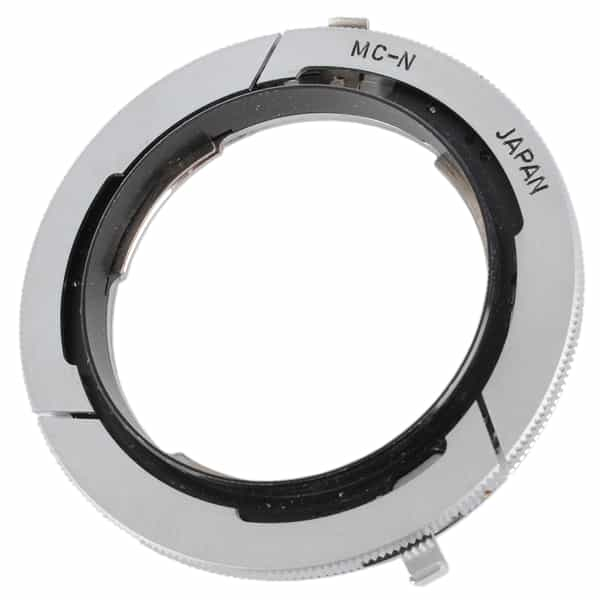
This is second version of the Converter N which I assume is the later production run in the late 1970’s. I am guessing that “MC-N” stands for Mount Converter N. A pure guess.
In the early 1960’s Canon produced such a converter, the Lens Converter N for the F mount lenses. It was only produced for a short period and then production was suspended. This first version of the Converter, on the left above, is marked “BH MT. CONVERTER N”. At the time Bell & Howell was the representative of Canon in North America and I assume that “BH” refers to them.
In the later 1970’s another short production run of Converter N’s appeared but again it was short lived. This second version, shown on the right above, was basically the same device but the “MC-N” label is a mystery. Possibly it means Mount Converter N. I find it unusual that neither version actually says Canon on it. And yet, from what I read, these were made by Canon.
I can find no reference to these Converters in any of the catalogues or instruction manuals in the Library. Perhaps Canon did not want to be seen as promoting Nikon lenses!? It may have been a special order item for professional customers. In any event, there are not many around today on the collector market and they are pricey. Way more than for the Converter A, B, or E.
Think about this. You put a Converter B on your Canon Model III rangefinder camera and then mount the Converter N on that and then a big Nikkor lens. Then go to a camera show or camera club meeting and listen to the comments! That would be fun! You might even take some great pictures with it.
And a final note ……
There are still a couple of Canon Converters that I have still to discuss. I don’t have copies of them ( you can’t have one of everything! ) but I can tell you what I have learned about them. So, more to come. And I am not sure I know about all of the possible Canon devices. That will require more searching.
And there are the third party Converters. I use several of them to great effect, especially for trying out different lenses and bodies. I will eventually get to discussing those as well. So stay tuned!
This website is the work of R. Flynn Marr who is solely responsible for its contents which are subject to his claim of copyright. User Manuals, Brochures and Advertising Materials of Canon and other manufacturers available on this site are subject to the copyright claims and are the property of Canon and other manufacturers and they are offered here for personal use only.

